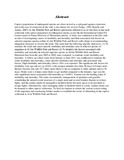| dc.description.abstract | Captive populations of endangered species are often viewed as a safeguard against extinction, and in
the case of extinction in the wild, a last chance for revival (Tudge, 1992; Rusello and Amato, 2007).
Al Ain Wildlife Park and Resort (previously referred to as Al Ain Zoo) is one such collection with
captive population of endangered species as per the the International Union For Conservation of
Nature Red List of Threatened species. A study was conducted at the Zoo with an aim of investigating
causes of morbidity and mortality and their associated risk factors in selected ungulate species within
Al Ain Wildlife Park and Resort with a hope to recommending mitigation measures to reverse the
trend. The study had the following specific objectives: (1) To estimate the crude and cause-specific
morbidity and mortality rates in selected species of ungulates in Al Ain Wildlife Park and Resort (2)
To identify risk factors associated with morbidity and mortality in selected ungulate species in Al
Ain Wildlife Park and Resort. Historical data from the year 2005 to 2010 were evaluated to estimate
crude morbidity and mortality. A follow-up cohort study from January to June 2011 was conducted
to estimate the crude morbidity and mortality, cause-specific morbidity and mortality and associated
risk factors. High morbidity and mortality (above 10%) was reported. The significant risk factors for
morbidity were age and sex (p <0.01), with younger animals (less than 30 days) 6.8 times more likely
to become sick and 19.7 times more likely to die as compared to older animals (above 30 days). Males
were 2.4 times more likely to get morbid compared to the females. Age was the only significant factor
associated with mortality (p < 0.001). Trauma was the leading cause of morbidity and mortality. The
study recommends; management of antelopes and gazelles considering the natural social structure
of a single male and several females (harem) to reduce fights, and the surplus males be managed as
bachelor herds but more space to be provided to escape fights. Alternatively, since managing males as
bachelor herds is costly, surplus males can be donated to other captive collections. To look for options
to reduce the current overcrowding of the ungulates and conducting further studies to establish the
extent of inbreeding in the captive collection at Al in Wildlife Park and Resort. | en_US |


